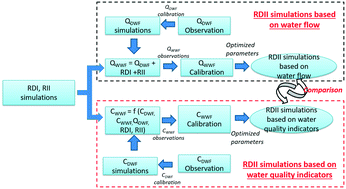Estimating rainfall-induced inflow and infiltration in a sanitary sewer system based on water quality modelling: which parameter to use?†
Abstract
Rainfall-derived inflow and infiltration (RDII) of urban sanitary sewer systems poses serious challenges for public health and management issues. Correct estimation of RDII is required for the maintenance of sewer infrastructure, such as sewer rehabilitation and replacement. This study aims to propose a suitable parameter for simulating RDII dynamics based on the variation patterns of wastewater quality indicators. Ten monitoring sewer sites ranging from residential areas to a wastewater treatment plant (WWTP) were equipped for continuous measurements of water flow and four wastewater indicators, including ammonia (NH4+-N), phosphate (PO43−-P), chemical oxygen demand (COD) and conductivity. In order to identify the most representative indicator for modelling the RDII dynamics, simulations based on different wastewater indicators were compared. Sensitivities of different wastewater indicators to RDII estimations were evaluated using the Kolmogorov–Smirnov test (KS test). The results revealed that conductivity was the most sensitive indicator for RDII simulations. Moreover, simulations of RDII based on conductivity have similar dynamics compared with that based on water flow, implying that conductivity could be considered as a suitable indicator for analyzing the RDII. Using the non-linear regression method for parameter optimization, RDII simulations based on conductivity gave promising results at all regional scales.



 Please wait while we load your content...
Please wait while we load your content...